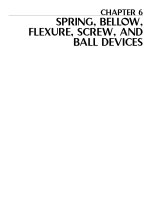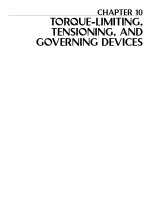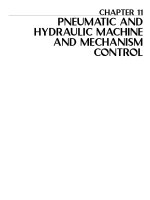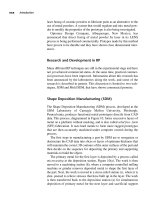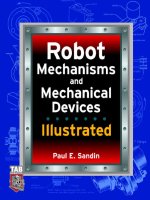Mechanisms and Mechanical Devices Sourcebook - Chapter 7
Bạn đang xem bản rút gọn của tài liệu. Xem và tải ngay bản đầy đủ của tài liệu tại đây (1.75 MB, 42 trang )
CHAPTER 7
CAM, TOGGLE, CHAIN,
AND BELT MECHANISMS
Sclater Chapter 7 5/3/01 12:32 PM Page 199
A cam is a mechanical component
that is capable of transmitting motion to
a follower by direct contact. The driver is
called a cam, and the driven member is
called the follower. The follower can
remain stationary, translate, oscillate, or
rotate. The motion is given by
y = f(θ),
where
y = cam function (follower) displace-
ment (in.).
f = external force (lb), and
θ = w
t
– cam angle rotation for dis-
placement
y, (rad).
Figure 1 illustrates the general form
of a plane cam mechanism. It consists of
two shaped members A and B with
smooth, round, or elongated contact sur-
faces connected to a third body C. Either
body A or body B can be the driver while
the other is the follower. These shaped
bodies can be replaced by an equivalent
mechanism. They are pin-jointed at the
instantaneous centers of curvature, 1 and
2, of the contacting surfaces. With any
change in relative positions, the points 1
and 2 are shifted and the links of the
equivalent mechanism have different
lengths.
Figure 2 shows the two most com-
monly used cams. Cams can be designed
by
• Shaping the cam body to some
known curve, such as involutes, spi-
rals, parabolas, or circular arcs.
• Designing the cam mathematically to
establish the follower motion and
then forming the cam by plotting the
tabulated data.
• Establishing the cam contour in para-
metric form.
• Laying out the cam profile by eye or
with the use of appropriately shaped
models.
The fourth method is acceptable only
if the cam motion is intended for low
speeds that will permit the use of a
smooth, “bumpless” curve. In situations
where higher loads, mass, speed, or elas-
200
CAM BASICS
Fig. 1 Basic cam mechanism and its kinematic equivalent (points 1
and 2 are centers of curvature) of the contact point.
ticity of the members are encountered, a
detailed study must be made of both the
dynamic aspects of the cam curve and
the accuracy of cam fabrication.
The roller follower is most frequently
used to distribute and reduce wear
between the cam and the follower. The
cam and follower must be constrained at
Fig. 2 Popular cams: (a) radial cam with a translating roller follower (open cam), and (b) cylindri-
cal cam with an oscillating roller follower (closed cam).
all operating speeds. A preloaded com-
pression spring (with an open cam) or a
positive drive is used. Positive drive
action is accomplished by either a cam
groove milled into a cylinder or a conju-
gate follower or followers in contact with
opposite sides of a single or double cam.
Sclater Chapter 7 5/3/01 12:32 PM Page 200
201
CAM-CURVE GENERATING MECHANISMS
It usually doesn’t pay to design a complex cam curve if it can’t be easily
machined—so check these mechanisms before starting your cam design.
Fig. 1 A circular cam groove is easily machined on a turret lathe by mounting the plate eccentrically onto
the truck. The plate cam in (B) with a spring-load follower produces the same output motion. Many designers
are unaware that this type of cam has the same output motion as four-bar linkage (C) with the indicated
equivalent link lengths. Thus, it’s the easiest curve to pick when substituting a cam for an existing linkage.
Fig. 2 A constant-velocity cam is machined by feeding the cutter and
rotating the cam at constant velocity. The cutter is fed linearly
(A) or circu-
larly (B), depending on the type of follower.
The disadvantages (or sometimes, the
advantage) of the circular-arc cam is that,
when traveling from one given point, its
follower reaches higher-speed accelera-
tions than with other equivalent cam
curves.
Constant-Velocity Cams
A constant-velocity cam profile can be
generated by rotating the cam plate and
feeding the cutter linearly, both with uni-
form velocity, along the path the translat-
ing roller follower will travel later (Fig.
2A). In the example of a swinging fol-
lower, the tracer (cutter) point is placed
on an arm whose length is equal to the
length of the swinging roller follower,
and the arm is rotated with uniform
velocity (Fig. 2B).
If you have to machine a cam curve into
the metal blank without a master cam, how
accurate can you expect it to be? That
depends primarily on how precisely the
mechanism you use can feed the cutter into
the cam blank. The mechanisms described
here have been carefully selected for their
practicability. They can be employed
directly to machine the cams, or to make
master cams for producing other cams.
The cam curves are those frequently
employed in automatic-feed mechanisms
and screw machines They are the circular,
constant-velocity, simple-harmonic,
cycloidal, modified cycloidal, and circu-
lar-arc cam curve, presented in that order.
Circular Cams
This is popular among machinists
because of the ease in cutting the groove.
The cam (Fig. 1A) has a circular groove
whose center,
A, is displaced a distance a
from the cam-plate center, A
0
, can simply
be a plate cam with a spring-loaded fol-
lower (Fig. 1B).
Interestingly, with this cam you can
easily duplicate the motion of a four-bar
linkage (Fig. 1C). Rocker
BB
0
in Fig. 1C,
therefore, is equivalent to the motion of
the swinging follower shown in Fig. 1A.
The cam is machined by mounting the
plate eccentrically on a lathe. Consequently,
a circular groove can be cut to close toler-
ances with an excellent surface finish.
If the cam is to operate at low speeds,
you can replace the roller with an arc-
formed slide. This permits the transmis-
sion of high forces. The optimum design
of these “power cams” usually requires
time-consuming computations.
Sclater Chapter 7 5/3/01 12:32 PM Page 201
202
ing roller follower of the actual am mech-
anism and the device adjusted so that the
extreme position of the center of
5 lie on
the center line of
4.
The cutter is placed in a stationary
spot somewhere along the centerline of
member
4. If a radial or offset translating
roller follower is used, sliding piece
5 is
fastened to
4.
The deviation from simple harmonic
motion, when the cam has a swinging
follower, causes an increase in accelera-
tion ranging from 0 to 18% (Fig. 3D),
which depends on the total angle of
oscillation of the follower. Note that for a
typical total oscillating angle of 45º the
increase in acceleration is about 5%.
Cycloidal Motion
This curve is perhaps the most desirable
from a designer’s viewpoint because of
its excellent acceleration characteristic.
Luckily, this curve is comparatively easy
to generate. Before selecting the mecha-
nism, it is worth looking at the underly-
ing theory of cycloids because it is pos-
sible to generate not only cycloidal
motion but a whole family of similar
curves.
The cycloids are based on an offset
sinusoidal wave (Fig. 4). Because the
Fig. 3 For producing simple harmonic curves:
(A) a scotch yoke device feeds the cutter while the
gearing arrangement rotates the cam; (B) a trun-
cated-cylinder slider for a cylindrical cam; (C) a
scotch-yoke inversion linkage for avoiding gearing;
(D) an increase in acceleration when a translating
follower is replaced by a swinging follower.
Simple-Harmonic Cams
The cam is generated by rotating it with
uniform velocity and moving the cutter
with a scotch yoke geared to the rotary
motion of the cam. Fig. 3A shows the prin-
ciple for a radial translating follower; the
same principle is applicable for offset
translating and the swinging roller fol-
lower. The gear ratios and length of the
crank working in the scotch yoke control
the pressures angles (the angles for the rise
or return strokes).
For barrel cams with harmonic
motion, the jig in Fig. 3B can easily be
set up to do the machining. Here, the bar-
rel cam is shifted axially by the rotating,
weight-loaded (or spring-loaded) trun-
cated cylinder.
The scotch-yoke inversion linkage
(Fig. 3C) replaces the gearing called for in
Fig. 3A. It will cut an approximate sim-
ple-harmonic motion curve when the cam
has a swinging roller follower, and an
exact curve when the cam has a radial or
offset translating roller follower. The slot-
ted member is fixed to the machine frame
1. Crank 2 is driven around the center 0.
This causes link
4 to oscillate back and
forward in simple harmonic motion. The
sliding piece
5 carries the cam to be cut,
and the cam is rotated around the center of
5 with uniform velocity. The length of arm
6 is made equal to the length of the swing-
Fig. 4 Layout of a
cycloidal curve.
D
Sclater Chapter 7 5/3/01 12:32 PM Page 202
radii of curvatures in points C, V, and D
are infinite (the curve is “flat” at these
points), if this curve was a cam groove
and moved in the direction of line
CVD,
a translating roller follower, actuated by
this cam, would have zero acceleration at
points
C, V, and D no matter in what
direction the follower is pointed.
Now, if the cam is moved in the direc-
tion of
CE and the direction of motion of
the translating follower is lined up per-
pendicular to
CE, the acceleration of the
follower in points,
C, V, and D would
still be zero. This has now become the
basic cycloidal curve, and it can be con-
sidered as a sinusoidal curve of a certain
amplitude (with the amplitude measured
perpendicular to the straight line) super-
imposed on a straight (constant-velocity)
line.
The cycloidal is considered to be the
best standard cam contour because of its
low dynamic loads and low shock and
vibration characteristics. One reason for
these outstanding attributes is that sud-
den changes in acceleration are avoided
during the cam cycle. But improved per-
formance is obtainable with certain mod-
ified cycloidals.
Modified Cycloids
To modify the cycloid, only the direction
and magnitude of the amplitude need to
be changed, while keeping the radius of
curvature infinite at points
C, V, and D.
Comparisons are made in Fig. 5 of
some of the modified curves used in
industry. The true cycloidal is shown in
the cam diagram of Fig. 5A. Note that the
sine amplitudes to be added to the con-
stant-velocity line are perpendicular to
the base. In the Alt modification shown
in Fig. 5B (named after Hermann Alt, a
German kinematician who first analyzed
it), the sine amplitudes are perpendicular
to the constant-velocity line. This results
in improved (lower) velocity characteris-
tics (Fig. 5D), but higher acceleration
magnitudes (Fig. 5E).
The Wildt modified cycloidal (after
Paul Wildt) is constructed by selecting a
point
w which is 0.57 the distance T/2,
and then drawing line
wp through yp
which is midway along OP. The base of
the sine curve is then constructed perpen-
dicular to
yw. This modification results
in a maximum acceleration of 5.88
h/T
2
.
By contrasts, the standard cycloidal
curve has a maximum acceleration of
6.28
h/T
2
. This is a 6.8 reduction in
acceleration.
(It’s a complex task to construct a
cycloidal curve to go through a particular
point
P—where P might be anywhere
within the limits of the box in Fig. 5C—
and with a specific scope at
P. There is a
growing demand for this kind of
cycloidal modification.
Generating Modified Cycloidals
One of the few methods capable of gen-
erating the family of modified cycloidals
consists of a double carriage and rack
arrangement (Fig. 6A).
The cam blank can pivot around the
spindle, which in turn is on the movable
carriage I. The cutter center is stationary.
If the carriage is now driven at constant
speed by the leadscrew in the direction of
the arrow, steel bands 1 and 2 will also
cause the cam blank to rotate. This rota-
tion-and-translation motion of the cam
will cut a spiral groove.
For the modified cycloidals, a second
motion must be imposed on the cam to
compensate for the deviations from the
203
Fig. 5 A family of cycloidal curves: (A) A standard cycloidal motion; (B) A modification
according to H. Alt; (C) A modification according to P. Wildt; (D) A comparison of velocity char-
acteristics; (E) A comparison of acceleration curves.
Sclater Chapter 7 5/3/01 12:32 PM Page 203
true cycloidal. This is done by a second
steel-band arrangement. As carriage I
moves, bands 3 and 4 cause the eccentric
to rotate. Because of the stationary
frame, the slide surrounding the eccentric
is actuated horizontally. This slide is part
of carriage II. As a result, a sinusoidal
motion is imposed on the cam.
Carriage I can be set at various angles
β to match angle β in Fig. 5B and C. The
mechanism can also be modified to cut
cams with swinging followers.
Circular-Arc Cams
In recent years it has become customary
to turn to the cycloidal and other similar
curves even when speeds are low.
However, there are still many applica-
tions for circular-arc cams. Those cams
are composed of circular arcs, or circular
arc and straight lines. For comparatively
small cams, the cutting technique illus-
trated in Fig. 7 produces accurate results.
Assume that the contour is composed
of circular arc
1-2 with center at 0
2
, arc 3-
4 with center at 0
3
, arc 4-5 with center at
0
1
, arc 5-6 with center at 0
4
, arc 7-1 with
center at
0
1
, and the straight lines 2-3 and
6-7. The method calls for a combination
of drilling, lathe turning, and template
filing.
First, small holes about 0.1 in. in
diameter are drilled at
0
1
, 0
3
, and 0
4
.
Then a hole drilled with the center at
0
2
,
and radius of
r
2
. Next the cam is fixed in
a turret lathe with the center of rotation at
0
1
, and the steel plate is cut until it has a
diameter of 2
r
5
. This completes the
larger convex radius. The straight lines
6-7 and 2-3 are then milled on a milling
machine.
Finally, for the smaller convex arcs,
hardened pieces are turned with radii
r
1
,
r
3
, and r
4
. One such piece is shown in
Fig. 7. The templates have hubs that fit
into the drilled holes at
0
1
, 0
3
, and 0
4
.
Next the arcs
7-1, 3-4, and 5-6 are filed
with the hardened templates as a guide.
The final operation is to drill the enlarged
hole at
0
1
to a size that will permit a hub
to be fastened to the cam.
This method is usually better than
copying from a drawing or filing the
scallops from a cam on which a large
number of points have been calculated to
determine the cam profile.
Compensating for Dwells
One disadvantage with the previous gen-
erating machines is that, with the excep-
tion of the circular cam, they cannot
include a dwell period within the rise-
and-fall cam cycle. The mechanisms
must be disengaged at the end of the rise,
and the cam must be rotated the exact
number of degrees to the point where the
204
Fig. 6 Mechanisms for generating
(A) modified cycloidal curves, and (B)
basic cycloidal curves.
Fig. 7 A technique for
machining circular-arc
cams. Radii r
2
and r
5
are
turned on a lathe; hard-
ened templates are
added to r
1
, r
3
, and r
4
for
facilitating hand filing.
Sclater Chapter 7 5/3/01 12:33 PM Page 204
205
Fig. 8 Double genevas with differentials for obtain-
ing long dwells. The desired output characteristic (A) of
the cam is obtained by adding the motion (B) of a four-
station geneva to that of (C) an eight-station geneva.
The mechanical arrangement of genevas with a differ-
ential is shown in (D); the actual device is shown in (E).
A wide variety of output dwells (F) are obtained by vary-
ing the angle between the driving cranks of the
genevas.
fall cycle begins. This increases the pos-
sibility of inaccuracies and slows down
production.
There are two mechanisms, however,
that permit automatic cam machining
through a specific dwell period: the dou-
ble-geneva drive and the double eccen-
tric mechanism.
Double-Genevas with
Differential
Assume that the desired output contains
dells (of specific duration) at both the
rise and fall portions, as shown in Fig.
8A. The output of a geneva that is being
rotated clockwise will produce an inter-
mittent motion similar to the one shown
in Fig. 8B—a rise-dwell-rise-dwell
motion. These rise portions are distorted
simple-harmonic curves, but are suffi-
ciently close to the pure harmonic to
warrant their use in many applications.
If the motion of another geneva, rotat-
ing counterclockwise as shown in (Fig.
8C), is added to that of the clockwise
geneva by a differential (Fig. 8D), then
the sum will be the desired output shown
in (Fig. 8A).
The dwell period of this mechanism is
varied by shifting the relative positions
between the two input cranks of the
genevas.
The mechanical arrangement of the
mechanism is shown in Fig. 8D. The two
driving shafts are driven by gearing (not
shown). Input from the four-star geneva
to the differential is through shaft
3;
input from the eight-station geneva is
through the spider. The output from the
differential, which adds the two inputs, is
through shaft
4.
The actual mechanism is shown in
Fig. 8E. The cutter is fixed in space.
Output is from the gear segment that
rides on a fixed rack. The cam is driven
by the motor, which also drives the
enclosed genevas. Thus, the entire device
reciprocates back and forth on the slide
to feed the cam properly into the cutter.
Sclater Chapter 7 5/3/01 12:33 PM Page 205
206
Fig. 9 A four-bar coupler mechanism for replacing the cranks
in genevas to obtain smoother acceleration characteristics.
Fig. 10 A double eccentric drive for automatically cutting cams with dwells. The cam is
rotated and oscillated, with dwell periods at extreme ends of oscillation corresponding to
desired dwell periods in the cam.
Genevas Driven by Couplers
When a geneva is driven by a constant-
speed crank, as shown in Fig. 8D, it has a
sudden change in acceleration at the
beginning and end of the indexing cycle
(as the crank enters or leaves a slot).
These abrupt changes can be avoided by
employing a four-bar linkage with a cou-
pler in place of the crank. The motion of
the coupler point
C (Fig. 9) permits its
smooth entry into the geneva slot
Double Eccentric Drive
This is another machine for automati-
cally cutting cams with dwells. The rota-
tion of crank
A (Fig. 10) imparts an oscil-
lating motion to the rocker
C with a
prolonged dwell at both extreme posi-
tions. The cam, mounted on the rocker, is
rotated by the chain drive and then is fed
into the cutter with the proper motion.
During the dwells of the rocker, for
example, a dwell is cut into the cam.
Sclater Chapter 7 5/3/01 12:33 PM Page 206
207
FIFTEEN IDEAS FOR CAM MECHANISMS
This assortment of devices reflects the variety of
ways in which cams can be put to work.
Figs. 1, 2, and 3 A constant-speed
rotary motion is converted into a variable,
reciprocating motion (Fig. 1); rocking or
vibratory motion of a simple forked follower
(Fig. 2); or a more robust follower (Fig. 3),
which can provide valve-moving mecha-
nisms for steam engines. Vibratory-motion
cams must be designed so that their oppo-
site edges are everywhere equidistant
when they are measured through their
drive-shaft centers.
Fig. 4 An automatic feed for automatic
machines. There are two cams, one with
circular motion, the other with reciprocating
motion. This combination eliminates any
trouble caused by the irregularity of feeding
and lack of positive control over stock feed.
Fig. 5 A barrel cam with milled grooves is
used in sewing machines to guide thread.
This kind of cam is also used extensively in
textile manufacturing machines such as
looms and other intricate fabric-making
machines.
Fig. 6 This indexing mechanism com-
bines an epicyclic gear and cam. A plane-
tary wheel and cam are fixed relative to one
another; the carrier is rotated at uniform
speed around the fixed wheel. The index
arm has a nonuniform motion with dwell
periods.
Fig. 7 A double eccentric, actuated by a
suitable handle, provides powerful clamping
action for a machine-tool holding fixture.
Fig. 8 A mixing roller for paint, candy,
or food. A mixing drum has a small oscil-
lating motion while rotating.
Sclater Chapter 7 5/3/01 12:33 PM Page 207
208
Fig. 9 A slot cam converts the oscillating
motion of a camshaft to a variable but
straight-line motion of a rod. According to
slot shape, rod motion can be made to suit
specific design requirements, such as
straight-line and logarithmic motion.
Fig. 10 The continuous rotary motion of
a shaft is converted into the reciprocating
motion of a slide. This device is used on
sewing machines and printing presses.
Fig. 11 Swash-plate cams are feasible
for light loads only, such as in a pump. The
cam’s eccentricity produces forces that
cause excessive loads. Multiple followers
can ride on a plate, thereby providing
smooth pumping action for a multipiston
pump.
Fig. 12 This steel-ball cam can convert
the high-speed rotary motion of an electric
drill into high-frequency vibrations that
power the drill core for use as a rotary ham-
mer for cutting masonry, and concrete. This
attachment can also be designed to fit hand
drills.
Fig. 13 This tilting device can be designed so that a lever
remains in a tilted position when the cylinder rod is withdrawn,
or it can be spring-loaded to return with a cylinder rod.
Fig. 14 This sliding cam in a remote con-
trol can shift gears in a position that is oth-
erwise inaccessible on most machines.
Fig. 15 A groove and oval follower form
a device that requires two revolutions of a
cam for one complete follower cycle.
Sclater Chapter 7 5/3/01 12:33 PM Page 208
209
SPECIAL-FUNCTION CAMS
Fig. 1—A quick drop of the follower is
obtained by permitting the cam to be
pushed out of the way by the follower
itself as it reaches the edge of the cam.
Lugs
C and C
′
are fixed to the camshaft.
The cam is free to turn (float) on the
camshaft, limited by lug
C and the
adjusting screw. With the cam rotating
clockwise, lug C drives the cam through
lug
B. At the position shown, the roller
will drop off the edge of the cam, which
is then accelerated clockwise until its
cam lug
B strikes the adjusting screw of
lug
C
′
.
Fig. 2—Instantaneous drop is
obtained by the use of two integral cams
and followers. The roller follower rides
on cam
1. Continued rotation will trans-
fer contact to the flat-faced follower,
which drops suddenly off the edge of
cam
2. After the desired dwell, the fol-
lower is restored to its initial position by
cam
1.
Fig. 3—The dwell period of the cam
can be varied by changing the distance
between the two rollers in the slot.
Fig. 4—A reciprocating pin (not
shown) causes the barrel cam to rotate
intermittently. The cam is stationary
while a pin moves from
1 to 2. Groove 2-
3
is at a lower level; thus, as the pin
retracts, it cams the barrel cam; then it
climbs the incline from
2 to the new posi-
tion of
1.
Fig. 5—A double-groove cam makes
two revolutions for one complete move-
ment of the follower. The cam has mov-
able switches,
A and B, which direct the
follower alternately in each groove. At
the instant shown,
B is ready to guide the
roller follower from slot
1 to slot 2.
Figs. 6 and 7—Increased stroke is
obtained by permitting the cam to shift
on the input shaft. Total displacement of
the follower is therefore the sum of the
cam displacement on the fixed roller plus
the follower displacement relative to the
cam.
Fig. 2 A quick-acting
dwell cams.
Fig. 3 An adjustable-
dwell cam.
Fig. 1 A quick-acting floating
cam.
Fig. 5 A double-revolution cam. Fig. 6 An increased-stroke barrel cam. Fig. 7 An increased-stroke plate cam.
Fig. 4 An indexing cam.
Sclater Chapter 7 5/3/01 12:33 PM Page 209
Fig. 8—The stroke of the follower is
adjusted by turning the screw handle
which changes distance
AB.
Fig. 9—The pivot point of the con-
necting link to the follower is changed
from point
D to point C by adjusting the
screw.
Fig. 10—Adjustable dwell is obtained
by having the main cam, with lug
A,
pinned to the revolving shaft. Lug
A
forces the plunger up into the position
shown, and allows the latch to hook over
the catch, thus holding the plunger in the
up position. The plunger is unlatched by
lug
B. The circular slots in the cam plate
permit the shifting of lug
B, thereby
varying the time that the plunger is held
in the latched position.
REFERENCE
: Rothbart, H. A. Cams—
Design, Dynamics, and Accuracy, John
Wiley and Sons, Inc., New York.
Fig. 8 An adjustable roller-
position cam.
Fig. 9 An adjustable pivot-point cam.
Fig. 10 An adjustable lug
cam.
CAM DRIVES FOR MACHINE TOOLS
ADJUSTABLE-DWELL CAMS
This two-directional rack-and-gear drive
for a main tool slide combines accurate,
uniform movement and minimum idle time.
The mechanism makes a full double stroke
each cycle. It approaches fast, shifts
smoothly into feed, and returns fast. Its
point-of-shift is controlled by an adjustable
dog on a calibrated gear. Automatic braking
action assures a smooth shift from
approach to feed.
210
A cam drive for a tool-slide mechanism
replaces a rack feed when a short stroke is
required to get a fast machining cycle on auto-
matic machines. The cams and rollers are
shown with the slide in its retracted position.
Sclater Chapter 7 5/3/01 12:33 PM Page 210
211
TOGGLE LINKAGE APPLICATIONS IN DIFFERENT
MECHANISMS
Fig. 1 Many mechanical linkages are based on the simple toggle that con-
sists of two links which tend to line up in a straight line at one point in their
motion. The mechanical advantage is the velocity ratio of the input point A with
respect to the outpoint point B: or V
A
/V
B
. As the angle α approaches 90º, the
links come into toggle, and the mechanical advantage and velocity ratio both
approach infinity. However, frictional effects reduce the forces to much les than
infinity, although they are still quite high.
Fig. 2 Forces can be applied through other
links, and need not be perpendicular to each other.
(A) One toggle link can be attached to another link
rather than to a fixed point or slider. (B) Two toggle
links can come into toggle by lining up on top of
each other rather than as an extension of each
other. The resisting force can be a spring.
HIGH MECHANICAL ADVANTAGE
Fig. 3 In punch presses, large forces are
needed at the lower end of the work stroke.
However, little force is required during the
remainder of the stroke. The crank and con-
necting rod come into toggle at the lower
end of the punch stroke, giving a high
mechanical advantage at exactly the time it
is most needed.
Fig. 5 Locking latches produce a high mechanical advantage when in
the toggle portion of the stroke. A simple latch exerts a large force in the
locked position (Fig. 5A). For positive locking, the closed position of
latch is slightly beyond the toggle position. A small unlatching force
opens the linkage (Fig. 5B).
Fig. 4 A cold-heading rivet
machine is designed to give
each rivet two successive
blows. Following the first blow
(point 2) the hammer moves
upward a short distance (to
point 3). Following the second
blow (at point 4), the hammer
then moves upward a longer
distance (to point 1) to provide
clearance for moving the work-
piece. Both strokes are pro-
duced by one revolution of the
crank, and at the lowest point
of each stroke (points 2 and 4)
the links are in toggle.
Fig. 6 A stone crusher has two toggle linkages in series to obtain a
high mechanical advantage. When the vertical link
I reaches the top
of its stroke, it comes into toggle with the driving crank II; at the same
time, link III comes into toggle and link IV. This multiplication results in
a very large crushing force.
Fig. 7 A friction ratchet is mounted on a wheel; a light spring
keeps the friction shoes in contact with the flange. This device per-
mits clockwise motion of the arm I. However, reverse rotation
causes friction to force link II into toggle with the shoes. This action
greatly increases the locking pressure.
Sclater Chapter 7 5/3/01 12:33 PM Page 211
HIGH VELOCITY RATIO
Fig. 8 Door check linkage gives a high
velocity ratio during the stroke. As the door
swings closed, connecting link I comes into
toggle with the shock absorber arm II, giv-
ing it a large angular velocity. The shock
absorber is more effective in retarding
motion near the closed position.
Fig. 9 An impact reducer is on some
large circuit breakers. Crank I rotates at
constant velocity while the lower crank
moves slowly at the beginning and end of
the stroke. It moves rapidly at the midstroke
when arm II and link III are in toggle. The
accelerated weight absorbs energy and
returns it to the system when it slows down.
212
VARIABLE MECHANICAL ADVANTAGE
Fig. 10 A toaster switch has an increasing
mechanical advantage to aid in compressing a
spring. In the closed position, the spring holds
the contacts closed and the operating lever in
the down position. As the lever is moved
upward, the spring is compressed and comes
into toggle with both the contact arm and the
lever. Little effort is required to move the links
through the toggle position; beyond this point,
the spring snaps the contacts open. A similar
action occurs on closing.
Fig. 12 Four-bar linkages can be altered to give a
variable velocity ratio (or mechanical advantage).
(Fig. 12A) Since the cranks
I and II both come into
toggle with the connecting link III at the same time,
there is no variation in mechanical advantage. (Fig.
12B) increasing the length of link
III gives an
increased mechanical advantage between positions
1 and 2, because crank
I and connecting link III are
near toggle. (Fig. 12C) Placing one pivot at the left
produces similar effects as in (Fig. 12B). (Fig. 12D)
increasing the center distance puts crank II and link
III near toggle at position 1; crank I and link III
approach the toggle position at 4.
Fig. 11 A toggle press has an increasing
mechanical advantage to counteract the resist-
ance of the material being compressed. A rotating
handwheel with a differential screw moves nuts
A
and B together, and links I and II are brought into
toggle.
Fig. 13 A riveting machine with a reciprocating
piston produces a high mechanical advantage with
the linkage shown. With a constant piston driving
force, the force of the head increases to a maximum
value when links II and III come into toggle.
Sclater Chapter 7 5/3/01 12:33 PM Page 212
213
SIXTEEN LATCH, TOGGLE, AND TRIGGER DEVICES
Diagrams of basic latching and quick-release mechanisms.
Fig. 1 Cam-guided latch (A) has
one cocked, and two relaxed posi-
tions, (B) Simple overcenter toggle
action. (C) An overcenter toggle with a
slotted link. (D) A double toggle action
often used in electrical switches.
Fig. 2 An identically shaped cocking
lever and latch (A) allow their functions to
be interchangeable. The radii of the sliding
faces must be dimensioned for a mating fit.
The stepped latch (B) offers a choice of
several locking positions.
Fig. 3 A latch and cocking lever is
spring-loaded so that latch movement
releases the cocking lever. The cocked
position can be held indefinitely. Studs in
the frame provide stops, pivots, or mounts
for the springs.
Fig. 4 A latch mounted on a cocking
lever
allows both levers to be reached at
the same time with one hand. After release,
the cocking spring initiates clockwise lever
movement; then gravity takes over.
Fig. 5 A disk-shaped cocking has a ten-
sion spring resting against the cylindrical
hub. Spring force always acts at a constant
radius from the lever pivot point.
Sclater Chapter 7 5/3/01 12:33 PM Page 213
214
Fig. 6 A sleeve latch (A) as an L-shaped
notch. A pin in the shaft rides in a notch.
Cocking requires a simple push and twist
action. (B) The Latch and plunger depend
on axial movement for setting and release.
A circular groove is needed if the plunger is
to rotate.
Fig. 7 A geared cocking device has a ratchet fixed to a pinion. A torsion spring exerts
clockwise force on the spur gear; a tension spring holds the gar in mesh. The device is
wound by turning the ratchet handle counterclockwise, which in turn winds the torsion
spring. Moving the release-lever permits the spur gear to unwind to its original position
without affecting the ratchet handle.
Fig. 8 In this overcenter lock (A) clockwise
movement of the latching lever cocks and locks the
slide. A counterclockwise movement is required to
release the slide. (B) A latching-cam cocks and
releases the cocking lever with the same counter-
clockwise movement as (A).
Fig. 9 A spring-loaded cocking piece has cham-
fered corners. Axial movement of the push-rod
forces the cocking piece against a spring-loaded ball
or pin set in a frame. When cocking builds up
enough force to overcome the latch-spring, the cock-
ing piece snaps over to the right. The action can be
repeated in either direction.
Fig. 10 A firing-pin mechanism has a beveled collar on a pin. Pressure
on the trigger forces the latch down until it releases the collar when the pin
snaps out, under the force of cocking the spring. A reset spring pulls the
trigger and pin back. The latch is forced down by a beveled collar on a pin
until it snaps back, after overcoming the force of the latch spring. (A latch
pin retains the latch if the trigger and firing pin are removed.)
Sclater Chapter 7 5/3/01 12:33 PM Page 214
